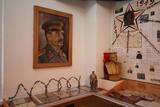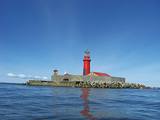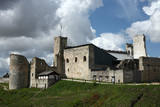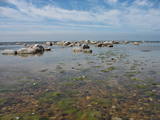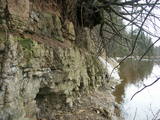| Нo | Название | Описание |
|---|---|---|
|
Парк усадьбы Ильзенберг отличается смешанной планировкой и сохранился в почти первозданном виде — таким, каким он был создан во второй половине XIX в. на живописном месте с выразительным рельефом, между озерами Апваласас и Ильгис. При восстановлении парка была сохранена его пространственная структура. Парк занимает 10 га и состоит из двух частей. Первая — это сравнительно правильная прямоугольная территория у дворца, ограниченная рядами сердцевидных лип и пейзажными группами местных и интродуцированных деревьев. Вторая часть представляет собой зеленые насаждения по типу естественного леса. Старый дуб из парка усадьбы Ильзенберг объявлен объектом природного наследия и находится под охраной государства. Охват ствола этого гиганта составляет 6,3 м, диаметр — 2 м, а высота — 30,5 м. |
||
|
В музее Курземской крепости можно осмотреть богатую экспозицию, посвященную военным действиям в Курземской крепости во время Второй мировой войны и дальнейшим судьбам латышских солдат. Здесь представлена экспозиция истории I и II мировых войн с коллекцией предметов военного и краеведческого характера, самолет YI-2, бронетранспортер, танк Красной Армии (одно из редких мест в Латвии, где сохранился такой объект) и отреставрированные окопы и бункеры того времени. Коллекция создана энтузиастом этого направления и местным краеведом.
|
||
|
This chapel is interesting in form and made of field stones. It was built in the 19th century and is not open to the public. |
||
|
Ģimenes uzņēmumā “Burka un ledus” audzē un pārstrādā asos piparus. Apmeklētājiem piedāvā degustācijas un ekskursiju pa ražotni. |
||
|
Biedrība ikvienam interesentam piedāvā praktiskas nodarbības ar taustāmiem rezultātiem - darbošanos ar savām rokām īstā darbnīcas vidē - koka amatniecība, rokdarbi, sveču liešana. Darbošanās patstāvīgi ar iespējamu palīdzību visos līmeņos, ko sniedz pieredzējuši meistari. Iepriekšējas iemaņas nav nepieciešamas. |
||
|
Колкский маяк – на искусственно созданном острове в море (остров
создан в 1872 – 1875 гг.) изначально был построен деревянный маяк, огни на
котором зажглись в июне 1875 года. Когда остров осел, здесь была построена
теперешняя башня маяка, которая начала свою работу 1 июля 1884 года.
Современный маяк находится на расстоянии 6 км (в момент постройки – 5 км)
от Колкасрага, в конце подводной песчаной мели. Еще на острове находится
здание смотрителя маяка и несколько хозяйственных построек. Металлическая
конструкция башни маяка высотой в 21 метр изготовлена в Санкт-Петербурге.
С 1979 года маяк работает в автоматическом режиме.
|
||
|
Хозяйство расположено вблизи города Зилупе. Под открытым небом выращиваются дыни, арбузы, тыквы. Хозяин – один из немногих в Латвии мастеров по плетению из бересты, хозяйка происходит из старинного рода садоводов и является дипломированным дизайнером-флористом, а их сын – гончар. Все ремесленники также проводят мастер-классы, творческие мастерские и принимают заказы. |
||
|
Пиццерия находится в Кулдиге недалеко от исторического центра города. В пиццерии Stender’s в милой и уютной атмосфере предлагают особые пиццы Stender's, которые приготовлены, соблюдая старинные традиции пекарей пиццы, объединив их с наилучшим современным опытом. Конечно же, не обходится без блинов и горшочков, а также вторых блюд. |
||
|
В замке турист оказывается в тематическом парке, представляющем жизнь и быт в замке 16-го века, где можно всей семьей провести захватывающий день, перевоплотиться в рыцарей и воинов. В замке можно покататься верхом, поупражняться в стрельбе из лука и арбалета, попробовать себя в профессиях кузнеца и плотника, чеканить монету, приготовить золото и порох. Открыты винный погреб, камера пыток, комната смерти, средневековый притон, мастерские цирюльника, алхимика, астронома. Расположенная в крепости корчма Шенкенберга предлагает блюда, приготовленные по средневековым рецептам. |
||
|
Витрупе – Туя - территория важна для охраны рифов. Она расположена напротив Салацгривского края, ее площадь составляет 3577 га. В территорию входит морская часть природного заказника «Видземское каменистое побережье».
|
||
|
Виргская господская усадьба как лен была передана вассалу Ливонского ордена Конраду Нолду. До наших дней сохранился дворец господской усадьбы «Виргас», в котором с 1935 года до наших дней разместилась школа. Во дворце находятся три двери, украшенные красивой резьбой по дереву, с гербами рода Нолдов и портреты баронов. В бывшей клети господской усадьбы в 1983 г. обустроен Дом традиций - теперь Дом культуры. Господскую усадьбу окружает парк, в котором находится место могилы барона Нолда и баронессы с памятником. В центре Вирги установлен сапог Карла XII с двумя направленными друг от друга пушками и ядрами, которые вещают о временах Северной войны, когда в Вирге в 1701 г. был лагерь шведского войска. |
||
|
Находится на улице Серавоту (Серных источников), 10. Постройка в стиле историзма возведена из дерева в 1899 году и является самой младшей из трех церквей Кемери. Днем, когда происходят богослужения, церковь можно осмотреть изнутри, а в остальное время – снаружи |
||
|
This is a unique geological object of paleontological importance. Up to four metres high, the cliff has yielded up fossils of ancient invertebrates and fish.
|
||
|
Гауя – это самая популярная река Латвии у водных туристов. Водных туристов влекут сюда красивые обнажения песчаника, спокойное течение реки, природное многообразие и большое многообразие памятников культуры. На описанном участке река течет через древнюю долину Гауи, которая является одной из самых впечатляющих форм балтийского рельефа. Самое технически сложное место на маршруте – пороги Кукю, где нередко случается, что опрокидывается лодка. Информация о маршруте от Latvijas Lauku forums |
||
|
Atrodas netālu no Biksēres muižas, blakus muižas parkam. Ozolkalna klēts saimniece Līga Kuba aušanas prasmes pirms pāris gadiem apguvusi Sarkaņu amatu skolā. Šeit radusies iecere par privātas aušanas darbnīcas izveidi, kas arī īstenota. Saimniece savas aušanas prasmes nodod jebkuram interesentam. Apmeklētāji var iegādāties šeit darinātos suvenīrus. |
||
|
Trušu audzēšanas saimniecība "Trušu muiža" savā allaž tapšanas procesā esošajā garaušu muižas kompleksā piedāvā aplūkot 15 – 20 dažādu šķirņu trušus no visas pasaules, kā arī iegūt bildi ar trusi. Lieliska iespēja ciemoties trušu "Harmonijas un miera sētā", tos samīļot, pabarot. "Trušu muiža" iegūst aizvien jaunus kaimiņus un pilnveidojas. Iespēja iegādāties "Trušu muižas" greznumlietas. Vaislas truši un mīļdzīvnieki. Vasaras sezonā (jūnijs - augusts) gaidīs ciemos no otrdienas līdz svētdienai (11:00 – 18:00). Lielākas grupas, iepriekš vienojoties, uzņem arī citā laikā. |
||
|
The viewing area is near the top of the Vilce castle hill, with a view of the Rukūze River valley, Zaķi meadow, and surrounding forests. This is an unusual landscape for the region of Zemgale. The Vilce baronial estate is nearby.
|
||
|
Piedāvā ļoti gardus Lietuviešu tradicionālos ēdienus. Var pieņemt līdz 80 personām. Pieņem bankas kartes, ir āra terase un dzīvā mūzika. Pieejama autostāvvieta. |
||
|
Сохранилось предание, что спасшийся во время одного из кораблекрушений у Колкасрага датский купец в знак благодарности построил в Колке церковь. В Колке было несколько церквей, которые меняли свое местонахождение. Фундамент храма, построенного из валунов и наблюдаемого в наши дни, заложил бывший владелец Дундагской господской усадьбы Карл Людвиг Фердинанд фон дер Остен – Сакен. Храм построен на месте деревянной церкви (или вблизи), которая сильно пострадала во время Крымской войны. Первым начал строительство в 1885 году мастер строительных работ Отто Зивертс (архитектор T.Зейлер). В советское время церковь была разгромлена, и в ней был обустроен склад. Непременно стоит увидеть выполненную в современном стиле алтарную икону (художник Хелена Хейнрихсоне), которой нет равных ни в одной другой церкви. На этом месте до иконы находился крест. |
||
|
Sāmsalas ziemeļrietumu daļā jūrā iestiepjas iespaidīgā Tagameizas pussala (Tagamõisa poolsaar). Tās ziemeļrietumu daļā meklējama mazāka – ap 5 km garā Harilaidas pussala (Harilaid). Pussalas vidusdaļā viļņojas Lajalepas ezers (Laialepa järv) - bijušais jūras līcis, kas zemes garozai ceļoties, kļuvis par iekšēju ūdenstilpi. Arī pati Harilaida (igauniski „laid” nozīmē „saliņa”) vairāk nekā trīs gadsimtus atpakaļ bijusi sala. Harilaidu iecienījuši ne tikai migrējošie putni, bet arī roņi, kurus piesaista vientuļi līči un akmeņainās sēres. Harilaidu var apmeklēt tikai ar kājām vai ar divriteni, bet spēkrati ir jāatstāj autostāvlaukumā. No tā ~ 1 km attālumā atrodas vieta, kur pēc 17. gs. radies Harilaidas savienojums ar Sāmsalu. Šeit paveras nepierasti klaja un akmeņaina ainava. Pārējā Harilaidas daļa ir apmežota pirms ~ 40 gadiem. Kopumā būs jāveic ~ 10 km garš pārgājiens. |
||


